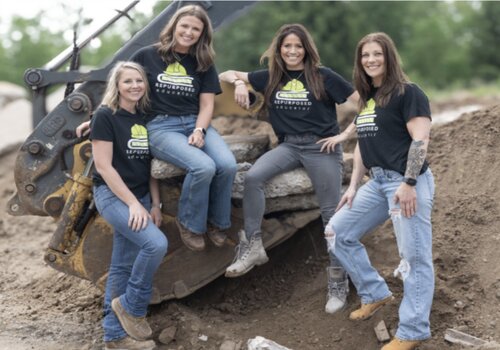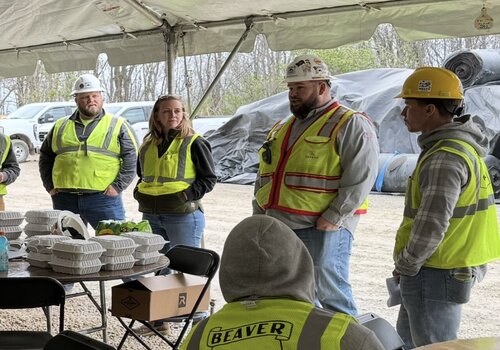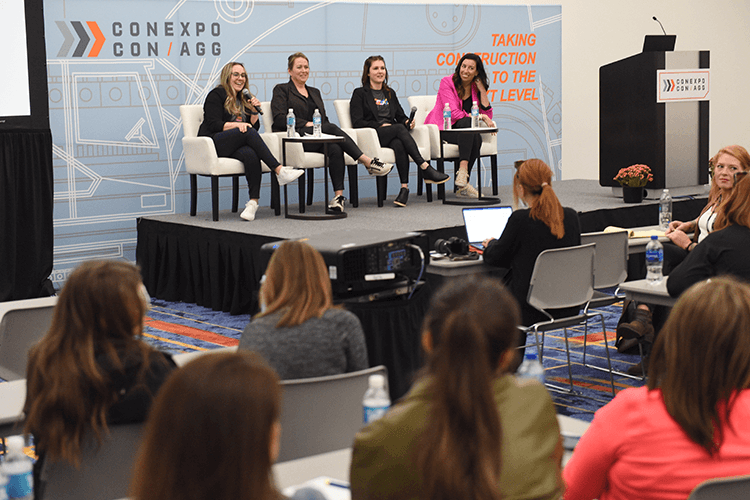Jake Schmidtlein believes the strongest thing you can build in construction is your people—and he’s on a mission to prove it.
Growing up in the trades, Jake spent summers on job sites with his dad, learning to operate heavy equipment before he could ride a bicycle. His grandfather built homes in the ’50s, and his family later founded a civil dirt-work company.
Despite this background, Jake took his father’s advice—get a degree, make more money, work fewer hours, have fewer headaches. He earned an MBA and spent 14 years in the financial industry.
When his firm was acquired, Jake seized the chance to return to construction. “This was my get-out-of-jail-free card,” he says. His career then took him through a beer distributor, a structural steel company, a racetrack and heavy equipment. Along the way, he learned a crucial lesson: people matter most in every industry.
Today, as Director of People Operations at Two Eight, Jake focuses on making culture, communication and leadership the core of the company. And it all starts with people.
Leadership Approach
In 2009, Jake witnessed a pivotal leadership moment that would define the rest of his career. At a company town hall with 2,000 attendees, the CEO broke a long silence by displaying his personal cell phone number on-screen and inviting anonymous texts. As questions began flooding in, Jake saw firsthand the power of genuine, intentional leadership.
“That was probably the most profound moment of my career around people and leadership,” Jake says. “because it showed that he cared so much about what the team had to say that he was willing to try new ideas.”
This story informs Jake’s leadership approach today. “If you really do care, then you must be intentional and take action and not accept the silence.”
Intentional Workforce Development
The biggest gap in construction with people and training that Jake sees is “intentionality.” He sees companies sending crews to a weekend seminar only to lose momentum once Spring’s heavy workload returns.
That’s why at Two Eight, everything they do is with its workforce in mind.
When a new hire starts at Two Eight, the first three full days are spent not on job sites but in the office “to learn about culture values, process beliefs, team mindset.”
Jake says this “mandatory and nonnegotiable” training sets a tone of belonging and purpose from day one. No matter how busy the company is, these first days are a time that makes the largest difference in showing people the company cares for them.
“It's not training on how to do your job. It's three days of who is Two Eight? How do we operate? What do we stand for? And what does it mean to work here?”
If you maintained your people like you do your equipment, you’d have a lot less turnover.
Jake Schmidtlein, MBA
Director of People Operations at Two Eight
Invest in Leaders
Jake has built a network with his 22 mid-level managers who are spread across 13 states to ensure each micro-culture aligns with overarching values of Two Eight. This midlevel leadership focus allows the company to reach every worker where they are for a more consistent company culture. “An organization's culture is the sum of all the subcultures,” Jake explains.
Leadership training for the mid-level managers is accomplished with weekly meetings and quarterly, multi-day sessions that all build on a year-long theme. Instead of one-offs, this allows in-depth leadership training. “It's about being candid and giving feedback and holding people accountable.”
In the trades, many in leadership positions are there because they worked their way up, not because they have the skills needed to lead. That’s why it is so important for Two Eight to invest in their leaders. This includes role playing how to respond when a worker is going through a family emergency or struggling with mental wellness. “They haven't been coached and taught the skill sets of true leadership,” Jake explains.
Jake challenges companies to invest in their people daily like they would equipment. Most companies have fleet managers and mechanics for equipment. “Do you have the same support personnel on your team for your people that you do your equipment?” Jake asks.
Tell Your Story to Attract Talent
Addressing talent retention, Jake warns the biggest risk is keeping bad workers around because it will affect all the good workers. Jake shares how he once overheard a contractor justify poor culture brought about by a worker who was not fitting in. The contractor said, “somebody’s better than nobody.” But Jake pushed back, pointing out that keeping this bad apple around will end up hurting the entire workforce. “If you're not leading your business at an ‘A’ level, your top talent is going to leave.”
Jake says companies need to treat workforce development as an investment—often with returns expected over 3-5 years, not 90 days. “I changed my mindset early on that. These initiatives were not an expense. I started viewing them all as an investment.”
Construction is full of meaning—but most companies miss the chance to celebrate it. In Jake’s eyes, the narrative is powerful. One story stands out: a beloved operator, Terry Peeves, who, facing terminal illness, asked for “one more ride with his loader.” His casket was placed on a lowboy under that machine at his funeral. Jake wonders why these types of stories are not being shared more often to attract workers.
“Why would anybody not want to be a part of this industry?” he asks, adding. “I don't know any accountants that have asked to be buried with their calculators.”
He challenges companies to lead job postings with a story and purpose. Job postings that only highlight paid leave and 401(k)s are not going to attract workers, especially the younger generation. Companies need to share what makes them unique to get people excited to apply and stay. Lead with your story; don’t “commoditize” people.
“You'll get some people that are more excited to come work for you,” Jake explains. “And they're not going to leave over 50 cents.”
Listening—The Most Powerful Tool
Leaders must know how to listen to understand. “You've got to teach the leaders in your organization how to listen—truly listen,” Jake advises. “This has been a monumental thing for us.”
Jake highlights three modes of listening: faux listening (fake, distracted nodding); listening to respond (already thinking of your answer); and true listening to understand (set aside your agenda).
“At this point, you quit trying to respond. You quit worrying about your agenda and you focus on putting yourself in the other person's shoes with full empathy and understanding of where it is they're coming from,” Jake says about true listening.
Teaching your leaders how to truly listen helps a company understand concerns, improve processes and even change a life. With mental health and suicide a problem across the trades, listening to understand could truly save a life.
“Find a way to teach your people how to listen, to understand what it is that employee is trying to tell them.”
Blueprint for Success
In a world where people are your greatest asset, Jake shows that you don’t just build projects; you build people—and through them, your company.
In Jake’s upcoming book, Nobody Wants to Suck: Build Your Employees’ Blueprint for Success, he draws on construction frameworks like blueprints and preventive maintenance to show leaders how to treat people like they treat equipment: inspect early, support often, prevent breakdowns.
“We do an oil sample on an excavator every 1,000 hours to check for signs of internal wear and failure to prevent a catastrophic breakdown” Jakes explains. “When was the last time you did an oil sample on the operator to check for their internal breakdowns before it becomes catastrophic? We do it with the job sites. We do it with the equipment. Let's just do it with the people.”
Want Help Building a Stronger Workforce?
Explore real-world strategies, training tools, and success stories that help contractors attract and retain great people. Visit the CONEXPO-CON/AGG Workforce Development Hub to get started.
PHOTOS COURTESY TWO EIGHT












